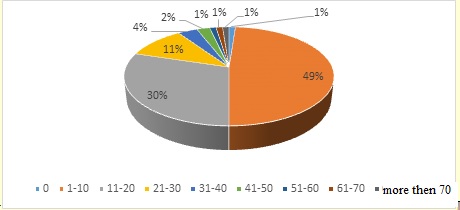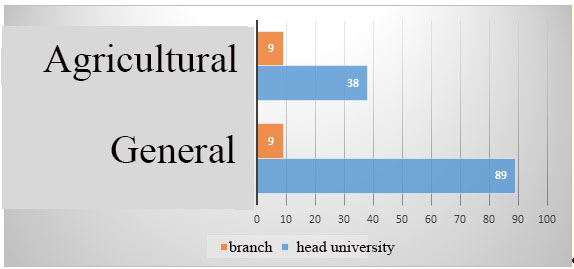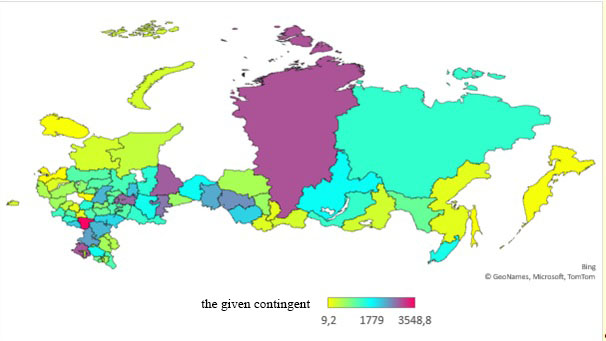Abstract
With the growing scale of the higher education system in all countries, there are increasing expectations of universities from all stakeholder groups: the population, businesses and the state. Universities must respond to the demands of the population, provide high quality education, provide businesses with human resources, work with inequalities in society, create and disseminate fundamental knowledge, produce innovation, work on the international market, contribute to urban and regional development and build local communities. There is an emerging new paradigm of territorial development as a "single corporation", whose main objective is to effectively manage the opportunities available to create special attractiveness in a wide range of areas. Human life expectancy, the length of a person's active life, depends on education many times more than health care, because from these behavioural attitudes we derive population savings and their ability to work. The main strategic goal of universities today is to contribute to the socio-economic development of regions, increase their competitiveness and turn them into "knowledge regions". Competition and scientific and educational potential are two inextricably linked components of the sustainable development of a territory. From this perspective, it is necessary to select and implement an optimal competitive model for the development of the territory, with regard to the existing potential and possibilities of its expansion, ensuring the sustainable development of the territory, created in a way to maintain its relevance and adequacy to the processes in the "big system" at all times.
Keywords: Agro-industrial complex, educational services, sustainable spatial development, territorial organization
Introduction
The agro-industrial complex is a crucial part of the Russian economy, providing society with vitally important products and concentrating huge economic potential. The development of the agro-industrial complex decisively determines the state of the entire national economic potential, the level of food security of the state and the socio-economic situation in society. This highlights the relevance of rational territorial distribution of agro-industrial educational services.
Problem Statement
Experts believe that sectoral territorial education primarily implies the implementation of the idea of a partnership between enterprises and educational institutions.
However, such a definition does not allow for a clear conclusion as to whether education is "sectoral". There seems to be a problem in defining the criteria for categorising education as "sectoral". On the one hand, the specialisation of the educational organisation may be such a criterion. If an educational organisation trains professionals for only one particular branch of knowledge or area of activity, it is possible to consider such an educational organisation as a sectoral one and to consider the education received as "sectoral". Broadly speaking, any vocational education will be "sectoral" as it corresponds to a specific field of knowledge.
Research Questions
The regions of Russia vary considerably in the size of their higher education systems.
In 49% of the regions, the number of HEIs and their branches varies from 1 to 10, in 30% of the regions - from 11 to 20 HEIs (Figure 1). Key university centres are concentrated in Moscow (147 HEIs), the Moscow Region (57 HEIs) and St Petersburg (66 HEIs). All other regions have fewer than 50 universities. The only region without universities is the Nenets Autonomous Area.

It is important to note that the number of universities in a region is not directly proportional to the number of students in that region. For example, the leading regions in terms of the number of higher education institutions include:
1.Moscow – 147 universities
2.St. Petersburg – 66 universities
3.Moscow Region – 57 universities
4.Krasnodar Territory – 46 universities
5.Republic of Tatarstan – 41 universities
6.Rostov Region – 37 universities
7.Sverdlovsk Region – 34 universities
8.Stavropol Territory – 31 universities
9.Republic of Bashkortostan – 29 universities
While the leaders in terms of number of students include:
1.Moscow – 706,037 people
2.St. Petersburg – 300,419 people
3.Republic of Tatarstan – 147,928 people
4.Rostov Region – 138,411 people.
5.Sverdlovsk Region – 120,319 people
6.Krasnodar Territory – 114,734 people
7.Republic of Bashkortostan – 100,837 people.
8.Samara Region – 96,935 people.
9.Novosibirsk Region – 96,794 people
The number of students in 64.71% of entities is less than 1% of the total number of students in the Russian Federation. One entity has more than 10% of the total number of students in the Russian Federation, 1 entity has more than 5%, 2 entities have more than 3%, 8 entities have from 2.1% to 3.0%, 6 entities have from 1.6% to 2.0%, and 12 entities have from 1.0% to 1.5%.
These facts indicate a steady western trend of student migration, similar to the general trend of migration in the Russian Federation (Medvedeva et al., 2019).
The total number of students enrolled in higher education programmes in Bachelor's, Specialist and Master's degree programmes amounts to 4,174,944. Among them, 2,397,227 are full-time students, representing 57.42 %.
Purpose of the Study
The article is devoted to the study of the issue of the territorial organization of educational services as a factor of sustainable spatial development of the country and the outstripping growth of the agro-industrial complex.
Research Methods
According to the information and analytical materials on the results of monitoring the effectiveness of educational institutions of higher education in 2019, the system of higher agrarian education comprises 145 institutions of higher education, including 18 branches of educational institutions.
Considering the structure of agrarian education in terms of the orientation of educational institutions (Figure 2), we should note that only 38 universities implementing agrarian specialties have an agricultural orientation, while more than 70% of universities (89) belong to the category of educational institutions without specific activities, but implement training areas/specialties for the agro-industrial complex.

Table 1 shows the structure of agrarian education by departmental affiliation.
Findings
When considering the territorial distribution of the universities training specialists for the agro-industrial complex, there is a difference between universities with a general orientation and those with an agricultural orientation (Shirokorad, Pafnutova et al., 2020).
The largest number of general universities providing training for the agricultural sector is concentrated in Moscow (5 universities), St. Petersburg (5 universities) and Krasnoyarsk Territory (4 universities). Agricultural higher education institutions are mostly represented by one in each region, except for the Omsk region, the Sakha Republic, the Rostov region, the Ulyanovsk region and the Chelyabinsk region, where there are 2 agricultural higher education institutions each.
In all five cases, one of the two agricultural universities located in the same region is the head university and the other is its branch university.
This fact demonstrates an even distribution of agricultural higher education institutions in Russia, with no more than one head institution per region.
Analyzing the territorial distribution of the given number of students studying in Agriculture and Agricultural Sciences sector, there is a majority of students in Moscow - 7,886.3 people and in St. Petersburg - 5,270 people. Figure 3 shows the distribution of students in the remaining regions.

Along with Moscow and St. Petersburg, there are also regions where the cited contingent exceeds 2,500 students: Voronezh Region (3,548.8), Krasnoyarsk Region (2,969.85), Krasnodar Region (2,940.4), Sverdlovsk Region (2,894.8), Republic of Tatarstan (2,830.35), Chelyabinsk Region (2,718.8), Novosibirsk Region (2,541.3).
The total cited enrolment for the Agriculture and Agricultural Sciences sector is 102,382.85 people.
Conclusion
There are currently problems of interaction between the labour market and the education market in almost all sectors of the economy. The agro-industrial complex (AIC), at its current stage of development, is particularly in need of a balance between supply and demand of highly qualified personnel.
A balanced labour market is the basis of sustainable and effective innovative development of the economy, its competitiveness, the well-being and quality of life of the population and the survival of the state. However, there is currently an imbalance between the demand for workers on the labour market and the supply of workers with the necessary qualifications and the necessary numbers on the education market (Tsypkin et al., 2020a).
The agro-industrial complex today is one of the largest inter-industrial complexes, combining various sectors of the economy aimed at the production, processing of agricultural raw materials and bringing finished products to consumers (Shirokorad, Fadeeva et al., 2020). The scientific and technological component and innovation in the agro-industrial sector dictate the need to address the issues of highly qualified human resources in the agro-industrial sector.
The foundation for the strategic goals and objectives of agricultural education is primarily the training of highly qualified personnel for scientific and technical support for the development of those sectors of the agro-industrial complex that provide for accelerated import substitution of major types of agricultural products, raw materials and foodstuffs. The diversity of our country's natural and climatic conditions requires agricultural professionals to have the competences appropriate to the specifics of the region. An important task of agrarian education is to provide agribusiness with educational programmes oriented towards rapid adaptation to the requirements of scientific and technological progress. Education and science need to respond even more to the real needs of agriculture. The constant modernisation of the agro-industrial sector challenges educational institutions to train specialists in new agro-industrial technologies, on a modern material and technical basis.
The adoption of the State Programme for the Comprehensive Development of Rural Areas also entrusts agricultural higher education institutions with the task of promoting rural employment by disseminating and raising the level of agricultural education of the toilers. This involves a number of measures (an annual increase in the number of employees studying under apprenticeship contracts, as well as students undertaking practical training at agricultural enterprises), which, among other things, will improve the efficiency of interaction between educational institutions and agricultural producers (Tsypkin et al., 2020b).
The existing territorial distribution of agrarian universities makes it possible to train specialists in demand, which contributes to the retention of young people in the countryside.
References
Medvedeva, N. V., Vetrova, E. A., Kabanova, E. E., & Havanova, N. V. (2019). Social capital of territorial educational complexes: Development features and problems (using the example of Moscow). European Journal of Contemporary Education, 8(4), 819-827.
Shirokorad, I. I., Fadeeva, O. M., & Pafnutova, E. G. (2020). The green energy industry: Current challenges and trends in the development of professional qualifications in agricultural specialists. IOP Conference Series: Earth and Environmental Science, 579(1), 012107.
Shirokorad, I. I., Pafnutova, E. G., Fadeeva, O. M., & Oleksenko, O. M. (2020). Methods of analysis and assessment of the efficiency of agricultural land use by agrarian universities. IOP Conference Series: Earth and Environmental Science, 579(1), 012129.
Tsypkin, Y. A., Orlov, S. V., Kamaev, R. A., Feklistova, I. S., & Pakulina, H. S. (2020a). Innovative social and dominant development of the region and sustainable functioning of the social complex. Lecture Notes in Networks and Systems, 111, 241-251.
Tsypkin, Y. A., Orlov, S. V., Kamaev, R. A., Pakulina, A. A., & Kalinichenko, L. L. (2020b). Increase of quality of provision of social and information services to the population in the conditions of development of the digital economy. Lecture Notes in Networks and Systems, 111, 253-264.
Copyright information

This work is licensed under a Creative Commons Attribution-NonCommercial-NoDerivatives 4.0 International License.
About this article
Publication Date
01 February 2022
Article Doi
eBook ISBN
978-1-80296-123-2
Publisher
European Publisher
Volume
124
Print ISBN (optional)
-
Edition Number
1st Edition
Pages
1-886
Subjects
Land economy, land planning, rural development, resource management, real estates, agricultural policies
Cite this article as:
Shirokorad, I. I., Fadeeva, O. M., Pafnutova, E. G., & Oleksenko, O. M. (2022). Territorial Organisation Of Educational Services A Factor Of The Sustainable Spatial Development. In D. S. Nardin, O. V. Stepanova, & E. V. Demchuk (Eds.), Land Economy and Rural Studies Essentials, vol 124. European Proceedings of Social and Behavioural Sciences (pp. 17-23). European Publisher. https://doi.org/10.15405/epsbs.2022.02.3

